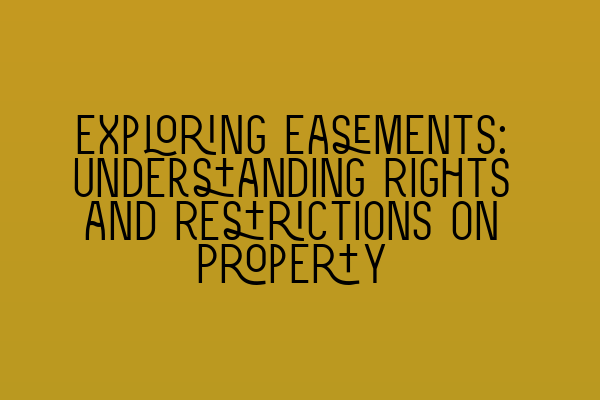Exploring Easements: Understanding Rights and Restrictions on Property
When it comes to property law, there are various legal concepts and rights that property owners and buyers need to be aware of. One such concept is the easement. In this article, we will explore easements in detail, aiming to provide a clear understanding of their nature and implications.
What is an Easement?
An easement is a legal right granted to one party (the easement holder) to use another party’s property in a specific manner, without giving them actual ownership or possession of the property. Easements can be both beneficial and restrictive, depending on the perspective of the parties involved.
Types of Easements
There are several types of easements, each serving a specific purpose and conferring certain rights and restrictions. Let’s take a closer look at some common types:
1. Right of Way: This is perhaps the most well-known type of easement. A right of way allows a person or entity to cross or pass through another person’s land. For example, a landlocked property may have a right of way over a neighboring property to access a public road.
2. Utility Easements: Utility companies often require easements to run utility lines, such as gas, water, or electrical cables, through private property. These easements ensure that utility companies have the right to access and maintain their infrastructure, even if it is located on someone else’s land.
3. Light and Air Easements: Sometimes, a property owner may grant an easement to protect their access to natural light and air. This type of easement prohibits neighboring properties from constructing buildings or installing structures that would obstruct light or restrict air circulation.
4. Drainage Easements: Properties that are prone to flooding may have drainage easements. These easements allow a property owner to divert surface water across another property, ensuring proper drainage and preventing flooding.
5. Conservation Easements: Conservation easements are often used to protect environmentally sensitive areas or historical properties. In these cases, the property owner voluntarily restricts certain uses or activities on their land to preserve its natural or cultural value.
6. Recreational Easements: Recreational easements grant public or private access to specific areas for recreational purposes, such as hiking, fishing, or hunting. These easements are usually granted by property owners who wish to share their land for the enjoyment of others.
Legal Implications of Easements
Easements create legally binding rights and obligations for the parties involved. As the property owner, it is crucial to understand the implications of granting an easement on your land. On the other hand, if you are the easement holder, you must be aware of your rights and limitations.
Easements can affect various aspects of property use, including:
1. Access and Use: Easements ensure that the easement holder has the right to access and use the specified portion of the property according to the terms of the easement agreement.
2. Maintenance and Repairs: Depending on the nature of the easement, the responsibilities for maintenance and repairs may fall on either the property owner or the easement holder.
3. Alterations and Construction: Easements may restrict the property owner from making certain alterations or constructions that could interfere with the easement holder’s rights. Conversely, the easement holder must not exceed the scope of their granted rights and interfere with the property owner’s enjoyment of their land.
4. Transferability and Termination: Easements can be transferred along with the property they benefit, but they can also be terminated if certain conditions are met or by mutual agreement between the parties.
Why You Need Professional Advice
Dealing with easements can be complex, and seeking professional legal advice is highly recommended. An experienced property law solicitor can help you understand the terms and implications of an easement, ensure that your rights are protected, and assist with any negotiations or disputes that may arise.
At SQE Property Law & Land Law, our team of expert solicitors is well-versed in all aspects of property law, including easements. Whether you are a property owner, buyer, or an easement holder, we can provide you with the guidance and expertise you need to make informed decisions and protect your rights.
Furthermore, if you are preparing for the SQE 1 or SQE 2 exams, make sure to check out our related articles and resources:
– SQE 1 Practice Exam Questions: Test your knowledge and prepare for the SQE 1 exam with our practice questions.
– SQE 1 Practice Mocks FLK1 FLK2: Gain practical experience and simulate the SQE 1 exam with our practice mocks.
– SQE 2 Preparation Courses: Get ready for the SQE 2 exam with our comprehensive preparation courses.
– SQE 1 Preparation Courses: Master the fundamentals of property law and other relevant topics with our SQE 1 preparation courses.
– SRA SQE Exam Dates: Stay updated with the latest exam dates and deadlines for the SRA’s SQE exams.
In conclusion, easements play a vital role in property law, providing rights and restrictions that can significantly impact property use and enjoyment. Understanding the different types of easements and their legal implications is essential for property owners, buyers, and easement holders. If you have any questions or concerns regarding easements or any other property law matters, do not hesitate to reach out to the experts at SQE Property Law & Land Law.
Contact us today to schedule a consultation and discover how we can assist you in navigating the complexities of easements and other property-related legal issues.
